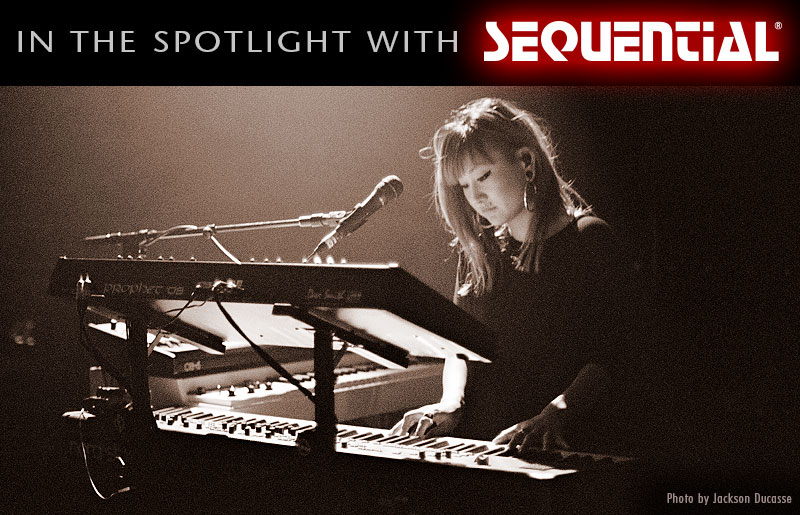
Hinako Omori is a musician with a love for synthesizers and anything that makes interesting sounds. Born in Yokohama, Japan she moved to London when she was three, where she is still based.
Initially training to be a sound engineer, she studied Music and Sound Recording at Surrey University then went on to work at record labels and distributors then at audio equipment manufacturer Focusrite/Novation. After session playing on the side, she leapt into music full time as a keyboard player and programmer – some of the artists Hinako has worked with include Georgia, Kate Tempest, KT Tunstall, James Bay, Jaakko Eino Kalevi, Ellie Goulding, and Fionn Regan.
Her move into creating her own music was instigated by her friend Hannah Peel, who asked her to remix of one of her tracks from her Mary Casio album. The track was included on Hannah’s own Mindfulness Mix on BBC Radio 1, and also played on BBC 6 Music and Radio 3.
The experience spurred her into creating her own musical journeys, combining ambientspace-synths with field recordings and her own ethereal vocals. Thematically, her music is influenced by the idea of space and infinity, floating into separate universes — everything being transparent and lucid, and the idea that nothing is permanent.
Alongside her teenage music-crush of The Knife, Hinako’s recent musical inspirations include Marie Davidson, Mark Pritchard, Katie Gately, Susan Sundfor and Tomoko Sauvage. Her debut single Voyage/Teleport is out now. Synth sounds evoke travelling to another realm in Voyage, and the feeling when you finally reach the other side in Teleport.
We chatted with Hinako about how she uses Sequential instruments in her music:
What made you choose Sequential synths?
My first contact with a Sequential synthesizer was at a friend’s soundcheck many years ago. I had the chance to noodle on their Prophet 12 for a few minutes, and instantly fell in love! It felt like a spaceship to me. It was one of the first synths I got to play with, and I was amazed at how immediately magic it sounded, and how tactile it was to use. After that moment I’d dreamed of getting my hands on a Sequential synth again and exploring further, so when I saw a Prophet ’08 for sale a few years later, I knew I had to get it. Since then, the wonderful OB-6 has joined the family, and more recently, the Prophet X. They are all so powerful, fun to program, and have their own warm, striking, and unique sound worlds while being extremely versatile. We also had the bright yellow Mopho on the road with us in Georgia’s band, and it definitely packed a punch.
Sequential has such an incredible heritage and it’s been fascinating and inspiring to delve into their history and legacy of beautiful synths. A couple of years ago I had the absolute pleasure of visiting SMEM in Fribourg (an incredible analogue synth warehouse/cave with any synth you could possibly dream of…) with my friends Dan and Sophie, where we had the opportunity to borrow their Prophet-5 and Pro One and use them in the studio on Sophie’s album Molecules. I was blown away by the warmth and richness of the sounds. I think we used the Prophet-5 on most of the tracks. It was very hard to part ways with it. I hope to track down a Prophet 10 one day.
How are you using your synths?
I’m using the Prophet ’08 and OB-6 on tour with James Bay at the moment. The Prophet ’08 I’ve mainly been using for programming lead lines and gated sequencer, and the OB-6 for warm, slurchy brass sounds and shimmering pads from James’ record Electric Light.
I also use both of these for writing and playing live with my solo project. I adore the space-like sounds and textures that you can create on the Prophet ’08. Most of the sounds on Voyage/Teleport as well as on a forthcoming EP were made on the Prophet ’08.
The Aftertouch assign panel on the OB-6 has been a lot of fun to experiment with — especially playing with the LFO amount and filter frequency, and simultaneously varying the portamento rate, to make some interesting and mad soaring soundscapes. The tap tempo is also very useful for the on-board delay etc..
I’m especially excited about the sample manipulation capability for sound design on the Prophet X, and the ability to time-stretch samples on the fly or create granular loops to make otherworldly textures.
The slop dial on the OB-6 is great for making things wonky, wobbly, and off-kilter. I’ve also been enjoying using the hidden distortion on the OB-6 to add some extra warmth and bite.
https://www.facebook.com/TV.Homework/videos/356055645208161/
LINKS
Prophet ’08 Performance Video by Homework
MORE ABOUT SEQUENTIAL
For more information, check out the Sequential product page here.
Find your local dealer for pricing here.
If you’re using Sequential products in interesting ways, tell us about it. Contact us at .
